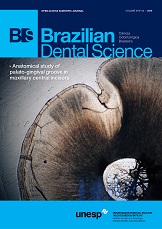Flexural strength of composites: effects of the activation techniques and fiber reinforcement.
DOI:
https://doi.org/10.14295/bds.2015.v18i3.1128Abstract
Objective: To evaluate the flexural strength of direct (Charisma) and indirect (Solidex) composites, with or without fiber reinforcements (Ribbond), cured with LED or Stroboscopic Xenon Light.MaterialandMethods: Resin bars made with or without fiber reinforcements, with 25mm x 2mm x 2mm were distributed in groups (n=10): GDL– Direct Resin/LED; GDX–Direct Resin/Stroboscopic Xenon; GDFL– Direct Resin/Fiber/LED; GDFX– Direct Resin/Fiber/Stroboscopic Xenon; GIL– Indirect Resin/LED; GIX– Indirect Resin/Stroboscopic Xenon; GIFL– Indirect Resin/Fiber/LED; GIFX– Indirect Resin/Fiber/Stroboscopic Xenon. The specimens were connected to a universal test machine and submitted to a compression load (2 kN).Results: The obtained results were submitted to Analysis of Variance tests (p < 0.01), and Tukey (5% significance level) tests. The flexural strength of groups that used polyethylene fiber reinforcement (96.39) was similar (p = 0.58) to group without fiber reinforcement (92.47). Direct composites (107.79) showed higher values of flexural strength than indirect composites (81.07), and stroboscopic xenon light curing (108.71) resulted in better flexural strength results than LED (80.15), for both kinds of composites experimented. Conclusion: The fiber reinforcement did not improve the composites’ flexural strength, direct composites showed higher flexural strength values, and stroboscopic xenon light showed better flexural strength results.
Keywords
Composite resins; Curing Lights; Fiber reinforcements; Physical properties.
Downloads
Downloads
Additional Files
Published
How to Cite
Issue
Section
License
Brazilian Dental Science uses the Creative Commons (CC-BY 4.0) license, thus preserving the integrity of articles in an open access environment. The journal allows the author to retain publishing rights without restrictions.
=================




























